Catapults are fun to build and play around with! Now-a-days, catapults are mostly used to study old weapon and some old catapult models are kept in the museums. Catapults are also widely used as experiments in engineering and physics classes to explain the students about the engineering design process concept.
DIY Catapult Models
Today we are going to learn different ways of making DIY Catapults using different key materials.
1. Easy Up cycled DIY Catapult
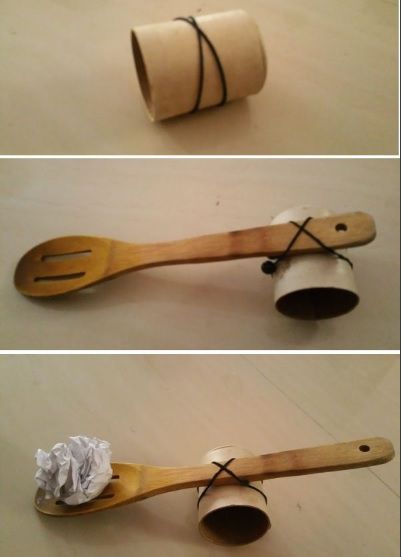
Now, you can make an up cycled catapult easily with this awesome STEM activity! All in the name of STEM, we are tinkering with the trash items around the home and learning physics in fun way. This is an environmental-friendly science project with the theme, ‘STEM goes Green’. Also, it takes a few minutes to prepare their own projectile launcher and kids will have fun straight away.
Explore fun physics experiment that suits kids of different ages differently. Want to know how it works!? Click on Easy Up cycled DIY Catapult
2. Build Catapults using Popsicle or Lolly Sticks
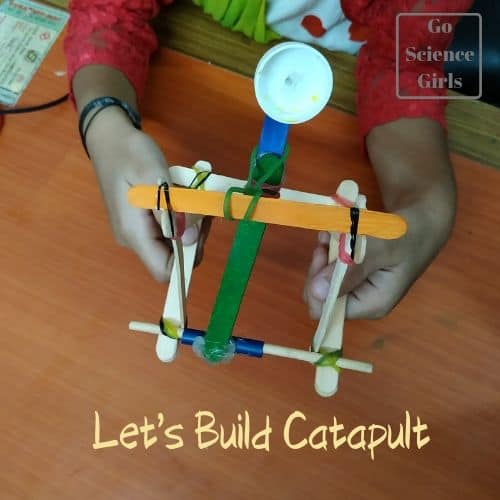
Check Our Collection of Innovative Catapults from Popsicle’s
You may be wondering of making catapults using left over Popsicle or lolly sticks around our house!! Check out this brilliant idea of making catapults while exploring STEM in this awesome and simple STEM project. Kids can experiment in different ways to build super cool catapults that shoot farther and more powerful.
Browse to get the complete details of this super classic STEM activity: Build Catapults using Popsicle or Lolly Sticks
3. Build a catapult using Tissue Box
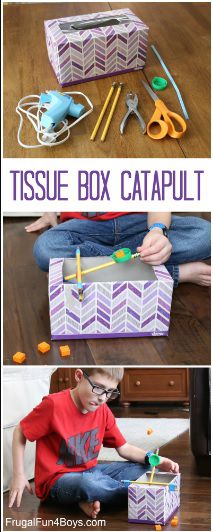
What do you do with the empty tissue boxes!? I think they go into the bin. I have come up with an innovative idea of turning your empty tissue boxes into a fun catapult. This super easy activity works effectively while keeping engaged in learning STEM and cracking engineering challenge. You only need a very few supplies to make this beautiful yet simple catapult as you can see in the picture. Do this easy craft with your kids and let them have lots of fun with their imagination and analysis.
Creative and innovative DIY catapult with complete instructions and full description: Click on Build a catapult using Tissue Box
4. Tinker Toy Catapult Experiment

Tinker Toy Catapult activity is pretty simple and takes just a few minutes to build! Designing, measuring, building, recording, and working as a team are the key skills kids will get to learn while participating in this super simple activity. It looks simple but the catapult can shoot up to 6-8 feet which is not far enough to hurt someone so it is cool and safe to construct.
Have a look at the complete description of this classic experiment and learn building Tinker Toy Catapult Activity
5. Make a Simple Catapult using PVC Pipes
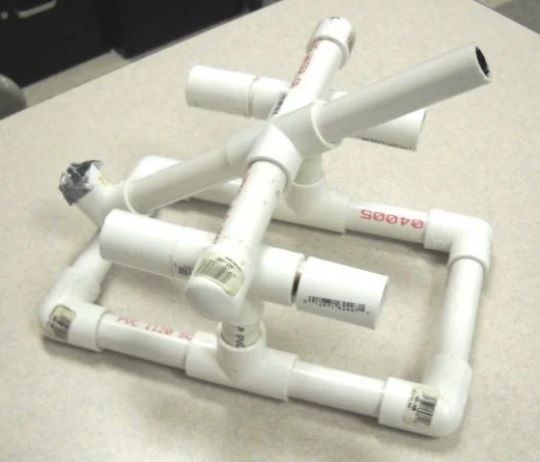
I found this idea of making PVC Catapult an excellent way to engage pre-schoolers and high schoolers to STEM and Engineering design challenge. Master your kids in building simple and effective catapults using PVC pipes creatively. Ask your children how PVC Catapult works and analyse the physics how effectively it works like other catapults. This encourages critical thinking in kids.
Learn how to build PVC Catapult so easily by clicking on Make a Simple Catapult using PVC Pipes
6. Build a Lego Catapult for young kids
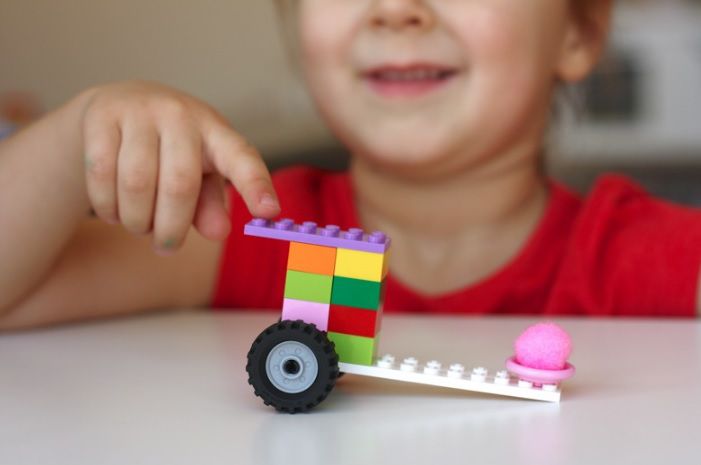
Playing with Lego pieces promotes fine motor skills and works as a wonderful exercise for little fingers. Let us turn their fun play with Lego pieces into a fun STEM activity of making simple catapults. This is a great STEM practice that offers trial and error method of learning which actually makes this Lego activity more fun and interesting. What would be the thrill that children get when they get everything perfect in their first trails!? Not much right! So, give it a try with Lego pieces and have a ton of fun while learning simple physics.
What all you need to build a Lego catapult!? Click on Build a Lego Catapult for young kids to learn all the easy directions.
7. Build a Catapult out of Dowel Rods and Rubber Bands
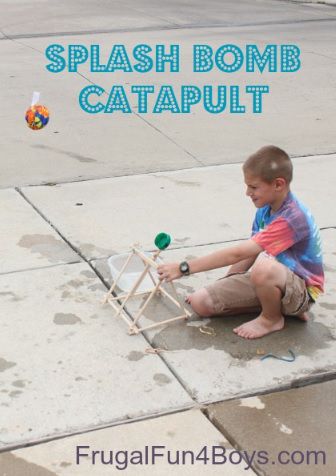
A great summer project of making wonderful catapults that shoots water bombs and ping pong balls effectively to the targeted distances. Water bombs are heavy to launch because of their heavy weight and wiggly shapes but this simple and classic catapult makes your target of launching water balloons easy! You and your kids can make this super cool catapult within minutes using pre-cut dowel rods and rubber bands.
What is so special trick that launches heavy water bombs so easily by this simple catapult? Learn the trick here: Build a Catapult out of Dowel Rods and Rubber Bands
8. Construct a Giant Catapult STEM Activity
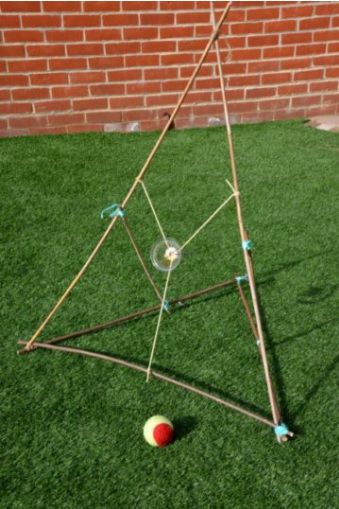
This amazing STEM activity utilizes a very few supplies that are easily available around our home to build a giant catapult that shoots surprisingly far. So don’t panic with the name thinking that it requires a lot many supplies to make! Also, it is made in less than 30’ leaving your children with hours of fun. Hope you will enjoy this wonderful DIY project that inspires a lot of investigation opportunities.
Have a look at the complete description here: Construct a Giant Catapult STEM Activity
9. Build Simple Wooden Catapults DIY
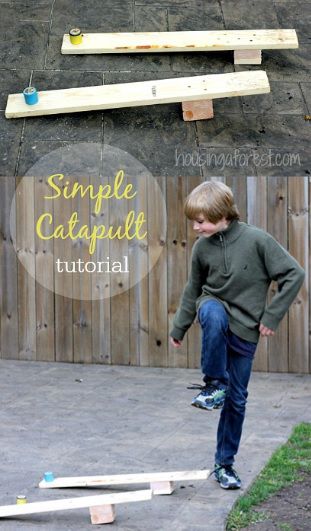
Another fun and super simple activity for toddlers, kindergarten, and pre-schoolers! Toddlers can simply enjoy watching the set up and fun while the objects are thrown far away. Kindergarten and pre-schoolers are encouraged for critical thinking on how the objects are thrown far into the air and how much distance the different sized projectiles are thrown. Great activity to improve their analysis capacity and skills!
Amaze your little kids with this super simple activity: Build Simple Wooden Catapults
10. Pool Noodle Catapult DIY Activity
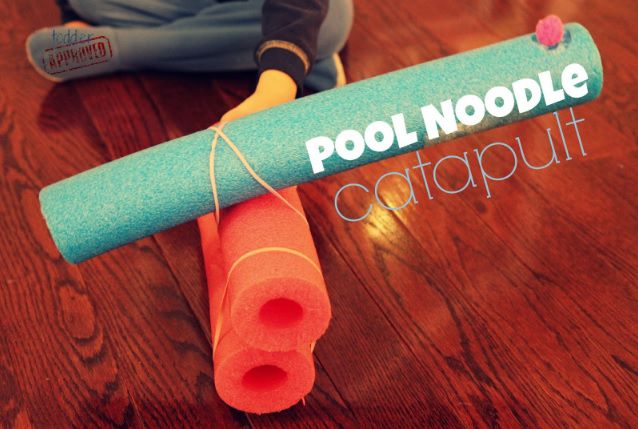
Pool noodles are versatile and hence are used to make an innovative and exciting Catapult making! Use this educational idea of making Pool Noodle Catapult in the pre-school, pre-K, and kindergarten classroom activities. Turn out your old pool noodles into a fun summer learning activity that teaches maths and science together while having fun out of flying things into the air.
Get the simple instructions required to make this super fun learning activity here: Pool Noodle Catapult Activity
11. Snowman Catapult Christmas DIY Activities

Awesome winter activity really works well for a Christmas party and a science fair project. This STEM activity is a great hands-on way to introduce our kindergarten children to STEM concepts in an effective way. If you are looking for new ways or activities to entertain and engage your children, this classic snowman craft activity to create simple catapults is for you!
Hurry up to learn the appropriate and complete instructions to make snowman catapults: Snowman Catapult Christmas Activities
12. Clothespin DIY Catapults for Kids
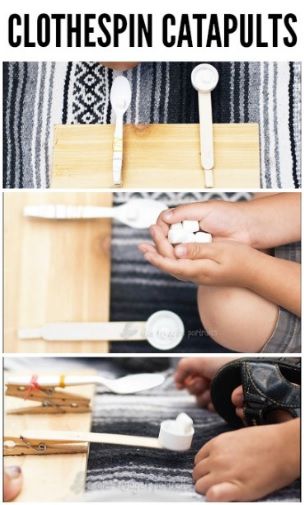
Cheaper version of building cloth spin catapults with different tensions! Simple, easy, and family-friendly DIY Cloth spin catapult. A great pre-school science activity that teaches force and motions in an excellent way. Super easy, simple and utilizes very few materials to bring lots of fun and laughs for kids!
Browse here to know the complete details of this experiment: Clothespin Catapults for Kids
13. Miniature Pencil DIY Catapult

Pencils are easy to find and easily fits in between our child’s little fingers and hence be perfect as a key material to make DIY catapults. We have turned our classic school supply into a wonderful STEM craft Pencil Catapult in an easy and classic way. Pencils offer not only good writing skills but also develops great learning skills of fine and motor while having lots of fun building a catapult. Your pre-school and home-school children can make it by themselves just like in the picture. Want to know how!? Browse: Miniature Pencil Catapult
14. DIY Ballista Catapult Activity for Older Kids
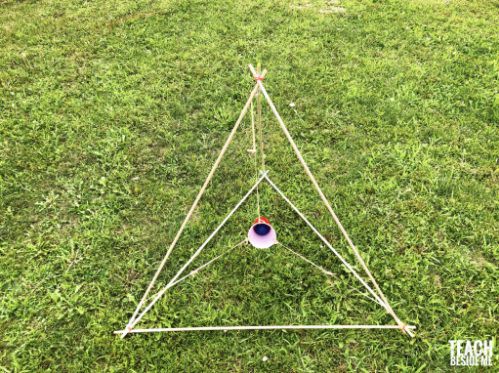
Create your own mini version of Ballista Catapult to demonstrate the concept of velocity and force. This may not be an exact Ballista catapult model but we are trying to make nearest closer model of ballista. Upper elementary children can easily make this project hands-on! Kids enjoy recording the distance travelled by the projectiles and take it as a challenge to throw farther than other projectile when other children are participating! Interesting and super exciting right!?
Do not wait to perform this super fun activity at your home: Click on Ballista Catapult Activity for Older Kids
15. Candy Corn Catapult for Halloween
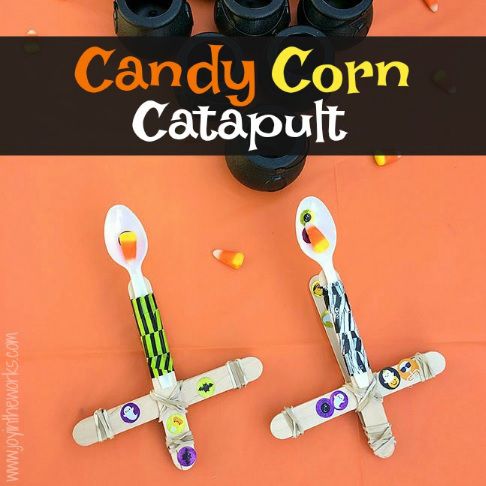
Learn catapult physics in a fun way with this Fall Halloween STEM activity! This wonderful activity is designed to create a simple candy corn catapult that launches candy corns to furthest distances. Perfect for all ages to do in the Fall, keeping kids entertained for hours! Also, kids find using candies fun and shows more interest to perform this activity. Check out this fun force and motion activity in an effective way. See the instructions here: Candy Corn Catapult for Halloween
16. Marshmallow Catapult for STEM
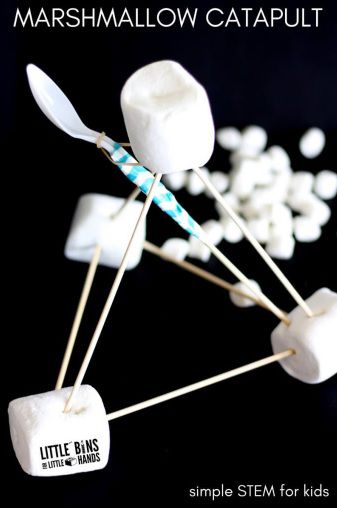
Marshmallows are everywhere and kids love to do experiment if they get any idea to explore STEM!! In this activity, kids get a great opportunity to build creative catapults using jumbo marshmallows and also they can launch mini marshmallows into the air. This STEM craft is a great learning tool to keep the kids engaged for hours with this little summer science. Also, kids improve their engineering skills while building this marshmallow catapults and explore little science while investigating its function on different sized objects.
Explore the physics and science involved in this marshmallow catapult activity: Marshmallow Catapult for STEM
17. Build a Mangonel Catapult using Peeps
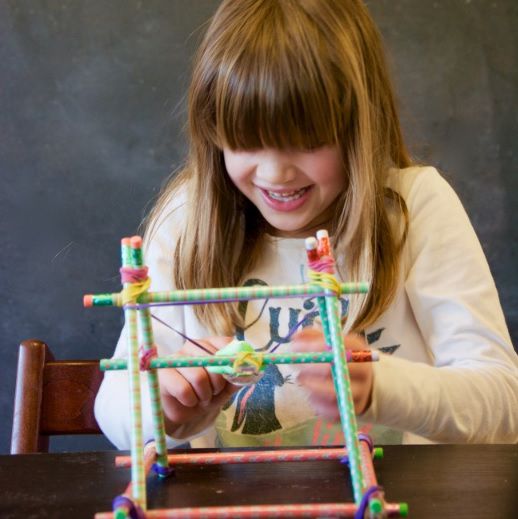
Mangonel Catapult, also referred as torsion catapult was invented during Middle Ages and stood as one of the most popular siege weapons. With this simple activity, kids of high school and pre-school are able to prepare mini Mangonels on their own using simple engineering, math, physics, and science skills. Awesome Peep STEM activity to do with elementary and kindergarten children for Easter and spring holiday vacation.
Get the interesting facts about this brilliant STEM activity in detail: Just Click on Build a Mangonel Catapult using Peeps
18. Simple DIY Catapult
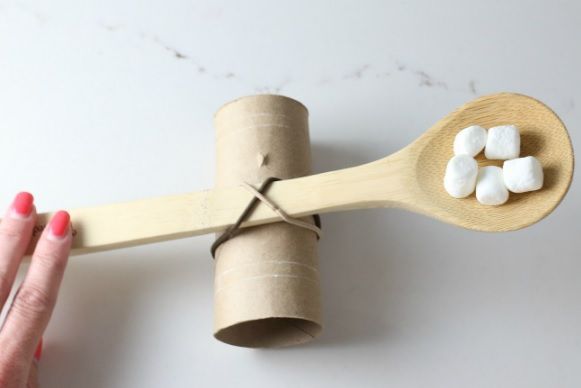
As the title suggests, this so simple activity of making simple catapults using only three ingredients and simple instructions. If your children are new to catapults, then this would be the perfect activity to introduce your younger kids to the catapult physics in a simple way. Initially, it starts out as a craft activity but ends with a ton of fun while making this simple catapult.
Here is the instructive and creative idea of making simple catapult for you and your kids: Simple DIY Catapult
Each and every model of catapult explained above is an effective way to introduce your children right from pre-school to high school to the fundamental concepts of experimental and engineering design. All the experiments are STEM activities which let children to practice design and technology concepts like elasticity, force, tension, gravity, etc. Explore the playful learning activities in a fun and clear way! Have lots of fun and make learning STEM easy!
Notes on Catapult & How it Works
A catapult is a device used as a weapon to launch projectiles such as stones, rocks, hot tar, etc. to a longer targeted distance without the aid of gun powder or other propellants in order to damage something else. How does a catapult work!?
A catapult works by using levers and weights to throw the projectiles farther away through the air. They were placed usually on the heights like on higher grounds or on top of the castle walls to let the rocks and other projectiles shoot farther. The usage of Catapults was very common during middle ages and are less effective than modern weapons.
The earliest form of catapults was the ballista and were used as a military weapon for long time and hence these catapults were called as ballistic devices. These ballista’s resembles today’s crossbows and were invented during the Greek and Roman period. Later, during medieval times catapults took the form of trebuchets to throw the objects or things to long distances. Eventually, the mangonel and onager types of catapults had been arrived and worked effectively. Whatever the form of a catapult, it just rely on energy stored to perform its function effectively.
Catapults use forces like gravity, tension, and torsion to make and store potential energy until it is launched and upon launching a projectile, the potential energy is turned into kinetic energy to throw the projectile to long distances through the air. This mechanism is named as the Engineering Design Mechanism and looks a lot like how a roller coaster works. It’s amazing to learn about catapults right! Now you can make your own mini versions of catapults in different ways using simple household items. Try it out!
